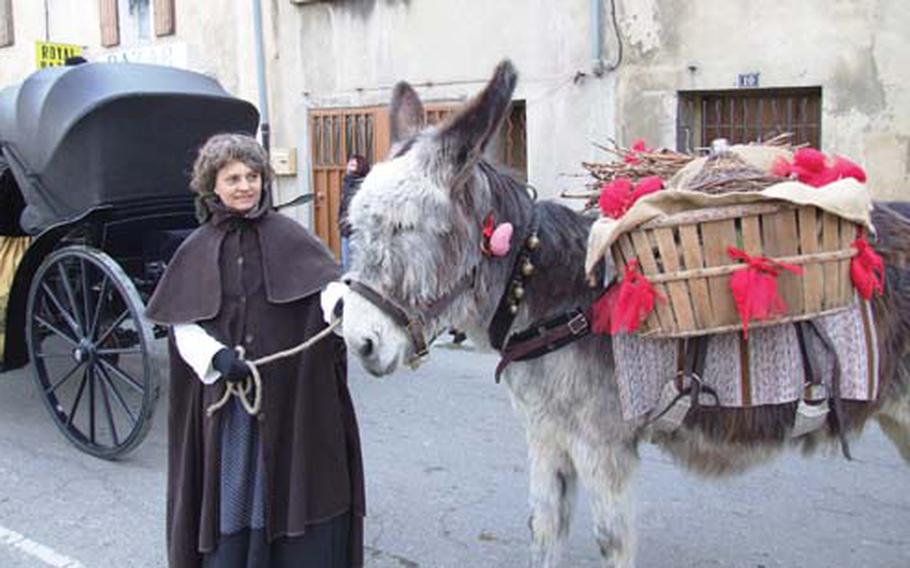
Even donkeys get decked out for the Valentine festivities during the the 2009 Festo di Poutoun, or the festival of lovers and kissers, in Roquemaure, France. The festival held on the weekend closest to Feb. 14, honors St. Valentine, the the patron saint of lovers, and his relics, which are supposed to protect the surround vineyards. (Leah Larkin/Special to Stars and Stripes)
Roquemaure, in southeastern France near Orange and Avignon, throws a huge party on the weekend closest to Feb. 14 — this Saturday and Sunday this year — to honor St. Valentine. It is called La Festo di Poutoun, or the festival of lovers and kissers.
As part of the ceremony, brown-robed monks take the relics of St. Valentine that normally rest in the town’s church and carry them through the streets. While that is the festival’s focus, there is more to it: Strolling musicians and entertainers, organ grinders, working craftsmen, costumed locals, food stands and more parades make it two days to remember. They all combine to create what my husband called “the best French festival I’ve ever been to.” (As we live in France, we’ve been to many).
Roquemaure, on the banks of the Rhône River, is in the heart of the wine-producing terrain known as the Côtes du Rhône. Disaster struck in 1866 when the vines were infested with phylloxera, tiny sap-sucking insects sometimes called the “deadly pest.” Fearing for the future, a wealthy landowner went to Rome to purchase relics of a saint that he hoped would save the town by restoring health to the devastated vineyards and protect them from similar infestations in years to come.
He returned with St. Valentine’s relics. The arrival was celebrated in October 1868 with a procession and singing and dancing in the streets.
Twenty-three years ago, the town decided to re-create those festivities.
The celebration has grown and now includes a festival of vine pruning in which vintners show how they bring new life to their vines, and a reunion of organ grinders from across Europe. The latter are found belting out songs throughout the town, some distributing song sheets to encourage passers-by to join in.
The organ grinders are not the only music-makers. Bands playing French folk tunes and old favorites are joined by groups of bagpipers performing Celtic music as they wander through the streets. There they mingle with performers on stilts towering above the crowds, jugglers surrounded by spectators and locals in 19th-century garb.
There’s a stand selling local wine (“wine of love”) and others offering products of the region, including cheese, bread, olive oil, confiture, sausages and more. Craftsmen — weavers, blacksmiths, stone masons and broom makers — demonstrate their trades. There’s even an old-time distillery where you can buy homemade brew, and a post office/souvenir stand where you can mail a Valentine message.
The procession with St. Valentine’s relics is supplemented by a reminder of what brought them to Roquemaure. Seven horse-drawn wagons, each loaded with shoots from the seven main wine varieties of the area, join the parade. So do more than 800 costumed participants, including 100 musicians and 40 organ grinders.
While the festival is held just once a year, the people of Roquemaure honor the saint year round. In their church, in addition to the relics, there is a representation of the saint clad in a ruby and gold robe lying in a gilded wooden case with glass panels. Couples in love come to light candles adjacent to the case.
According to one legend, Valentine’s connection with lovers can be traced to the third century in Rome, where he was a priest with a reputation for helping young couples. Claudius II, emperor at the time, declared that professional soldiers were not to marry, and then outlawed marriage when he began having trouble finding soldiers to fight his battles. Valentine came to the rescue, performing marriages in secret, which so enraged the emperor that he threw Valentine into prison.
While a prisoner, he was often visited by Julia, the jailer’s blind daughter. The two discussed Christianity and God, and when she suddenly regained her sight, it was declared a miracle. This further enraged the emperor, who ordered Valentine beheaded on Feb. 14, 268.
The origin of St. Valentine’s Day goes back even further. The Romans had a tradition of paying tribute to the she-wolf who suckled Romulus and Remus every Feb. 15 with the Lupercalia, a celebration of nature and fertility. The pagan festival featured half-naked young men running around Rome lashing young women with strips of skin from a slaughtered goat. This was supposed to make them fertile.
Christian popes tried to put an end to the festival, and in 495 Pope Gelasius I succeeded, replacing the pagan fest with the religious celebration of the martyr Valentine on Feb. 14. Pope Alexander VI named Valentine the patron saint of lovers in 1496 — an honor that has now spread around the world.
Photojournalist Leah Larkin lives in France and can be contacted through her Web site, www.leahlarkin.com, or blog address, www.provencetales.typepad.com.